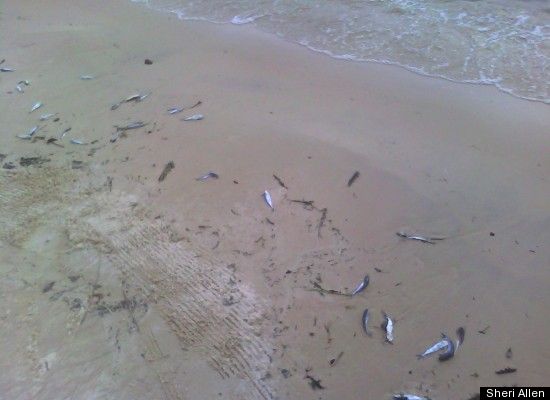Riki Ott: BP, Governments Downplay Public Health Risk From Oil and Dispersants (PHOTOS)

Estimated 300 to 400 dead fish washed ashore in Mobile Bay, Alabama, after the skin rash incident. The fish kill was reported to the Alabama Marine Resources Center. May 12, 2010.
ensacola Beach, FL -- When Ryan Heffernan, a volunteer with Emerald Coastkeeper, noticed a bag of oily debris floating off in Santa Rosa Sound, she ran up to BP's HazMat-trained workers to ask if they would retrieve it."No, ma'am," one replied politely. "We can't go in the ocean. It's contaminated."
Ryan waded in and retrieved the bag. That was Wednesday, June 23, the first day visible oil hit Pensacola Beach. Ryan had been swimming off the beach the day before, as she said, "to get in my last swim before the oil hit." The trouble is that not all of the oil coming ashore is visible. Dispersed oil - tiny bubbles of oil encased in chemical dispersants - are in the water column. On Thursday Ryan was treated at a local doctor's office for skin rash on her legs.
Three days later on Pensacola Beach, I watched BP's HazMat-trained workers shovel surface oiled sand and oily debris into bags early in the morning. The workers followed the waterline like shorebirds, scurrying up the beach in front of breaking waves and moving back down with receding waters.
The late morning sun retired the workers to the shade of their tents and the job of "observing," while it brought out throngs of beach-goers -- children, parents, grandparents -- who happily plunged into the "contaminated" ocean without a second thought.
I was astounded. Why did people think the ocean was safe for swimming?
There were five HazMat tents, four front-loaders, and at least two dozen HazMat workers on the beach. HazMat workers wore yellow over-boots duct-taped to their long pants' legs to minimize risk of contact with the water. The white surf popped with visible black tar balls as it rolled towards the beach. Waves left an oily signature of tar balls on the beach, melting in the sun. The treads of my Chacos weighed down with oily sand despite trying to avoid the mess. Most people were barefoot. Hotels set up oil cleaning stations on their premises - and signs saying the water advisory (put in place after Ryan's incident) had been lifted.
What's wrong with this picture?



No comments:
Post a Comment